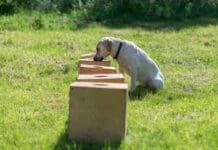There is no such thing as the one best fetch toy. The best fetch object is something that your dog really likes. So when WDJ asked me to review fetch toys, I was at a little bit of a loss. For one thing, if you walk into a large pet supply store or look in a catalog there are a bazillion choices – from various flying discs to flavored tennis balls to bumpers to squeaky toys. There’s no way I could review them all. For another, my test dogs’ favorite fetch toys may well be very different from your dog’s favorite fetch toy.
What I could (and did) do, however, is test a sampling of toys, point out the pros and cons of each, and tell you how I evaluated them. The most important points to consider are safety, durability, attractiveness to the dog, suitability for your environment, aerodynamics, and cost.
In general, heavy toys such as solid rubber or plastic bumpers (dummies), should only be used for structured retrieves where the dog sits (or downs) and stays while you throw, and then is given the cue to “Fetch.” Otherwise you may risk causing broken bones, bruises, cracked teeth or concussion! Other, lighter plastic fetch toys such as the ubiquitous FrisbeeTM are easily shredded and can lacerate your dog’s mouth with the resulting sharp edges, or cause intestinal problems if she swallows chunks of jagged plastic.
Also, please note that any activity you do with your dog that encourages her to fly through the air and land heavily on the ground inflicts wear and tear on joints and can contribute to arthritis problems later in her life. To minimize this risk, play on soft surfaces rather than hard ground or pavement, and do plenty of long, flat throws, not just spectacular aerial ones.
Fetch toys should be reserved for retrieve only; most are not sturdy enough to survive the abuse they would receive as chew toys. Your dog will be more interested in playing fetch if you reserve one special set of toys for retrieving games only. While the most durable fetch items may stand up to chewing, constant gnawing on hard objects can damage your dog’s teeth. Even tennis balls can wear down your dog’s teeth over time! Chew toys are for chewing – fetch toys are for fetching.
Because fetch item preference is a highly personal (dogonal?) choice, our favorite fetch toys may be entirely different from yours, but our experience should help you know what to look for when choosing fetch toys for your own dog.
-By Pat Miller





